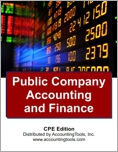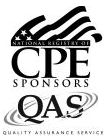Public Company Accounting and Finance (CPE Course)
CPE Credit: 13 hours
Course Type: Downloaded PDF materials with online test
Price (with PDF Textbook): $90
Course Description
This course shows the accountant how to deal with the unique aspects of accounting and finance in a publicly-held business. These issues are significantly different from those encountered in a private company, so this course can be crucial for the accountant who is making the transition from private to public companies. Topics covered include earnings per share, segment reporting, and Staff Accounting Bulletins, as well as quarterly and annual reporting to the SEC. In addition, the course addresses initial public offerings, registration statements, and selling shares under various SEC exemptions.
Author: Steven Bragg
Course Number: AC1075
Table of Contents
Chapter 1. The Public Company Environment
Chapter 2. Earnings per Share Reporting
Chapter 3. Segment Reporting
Chapter 4. Interim Reporting
Chapter 5. Stock Issuances Accounting
Chapter 6. Debt Accounting
Chapter 7. Staff Accounting Bulletins
Chapter 8. Annual and Quarterly Reporting
Chapter 9. Form 8-K Reporting
Chapter 10. Insider Securities Reporting
Chapter 11. Non-GAAP Reporting
Chapter 12. Fedwire Payments
Chapter 13. The Initial Public Offering
Chapter 14. The Reverse Merger
Chapter 15. Registration Statements
Chapter 16. Regulation A Stock Sales
Chapter 17. Sale of Unregistered Securities - Regulation D
Chapter 18. The Jumpstart Our Business Startups Act
Chapter 19. Sale of Unregistered Securities - Rule 144
Chapter 20. Rule 10b5-1 Stock Sales
Chapter 21. Closing the Books
Chapter 22. Accounting and Finance Controls
Learning Objectives
Cite the activities that the SEC oversees, and the disclosures that it is most careful in reviewing.
Specify the adjustments required to calculate diluted earnings per share.
Identify the methods used to determine which segments of a business are reportable.
Describe the process used to report segment information.
Specify the concepts involved in the use of the integral and discrete views of interim reporting.
Recognize the accounting to be used for stock options and employee share purchase plans.
Identify the method used to value the components of a convertible security.
Identify the proper reporting for a company filing a registration statement whose historical results are not indicative of its ongoing results.
Specify the proper accounting for fees paid to an investment banker under various circumstances.
Cite the required timing for the reporting of annual and quarterly reports, as well as the contents of those reports.
Specify the circumstances under which a change in independent accountant must be disclosed.
Specify the required timing for the filing of a Form 8-K, as well as the contents of the various disclosures.
Recognize the responsibility level of a company for the filing of the Forms 3, 4, and 5.
Describe the filing codes used by the Securities and Exchange Commission.
Identify the source of the disclosure requirements for non-GAAP information.
Recognize the circumstances under which Form 8-K disclosure of non-GAAP information is required.
State the informational content of a Fedwire payment.
Cite the restrictions placed on a company engaged in an initial public offering.
Recognize the registration process for the auditors of a public company.
Specify the reason why blue sky laws have been enacted.
Identify the filing requirements associated with a reverse merger.
Describe the advantages and disadvantages of using a reverse merger to go public.
Specify the advantages of the Form S-3 registration, as well as the situations in which a Form S-8 registration can be used.
Recognize the circumstances under which the Regulation A exemption can be used.
State the filing requirements associated with a Regulation D securities sale.
Recognize the types of investors who can now receive advertisements concerning the sale of securities.
Identify the requirements under which an investor is allowed to sell shares under Rule 144.
Specify the protection offered by Rule 10b5-1, and how an employee maximizes his or her protection under it.
Recognize the additional steps required by a public company to close the books, and the extra approvals involved.
Identify the types of controls, and which controls can be applied to the filing of certain SEC reports.
Level: Overview
Instructional Method: QAS Self-Study
NASBA Category: Accounting
Prerequisites: None
Advance Preparation: None
Latest Review Date: June 2024
Program Registration Requirements: Click on "Purchase Course" near the top of this page to pay for and access the course. You will then be able to download the course as a PDF file, then take an on-line examination, and then download a certificate of completion if you pass the examination.
Program Refund Policy: For more information regarding administrative policies concerning complaints, refunds, and other matters, see our policies page.
AccountingTools, Inc. is registered with the National Association of State Boards of Accountancy (NASBA) as a sponsor of continuing professional education on the National Registry of CPE Sponsors. State boards of accountancy have the final authority on the acceptance of individual courses for CPE credit. Complaints regarding registered sponsors may be submitted to the National Registry of CPE Sponsors through its website: www.nasbaregistry.org.
The NASBA sponsor identification number for Accountingtools, Inc. is 115881.
AccountingTools is an IRS Approved Continuing Education Provider. We are compliant with the requirements for continuing education providers (as described in sections 10.6 and 10.9 of the Department of Treasury’s Circular No. 230 and in other IRS guidance, forms, and instructions). Our IRS Approved Continuing Education Provider number is 72821.


